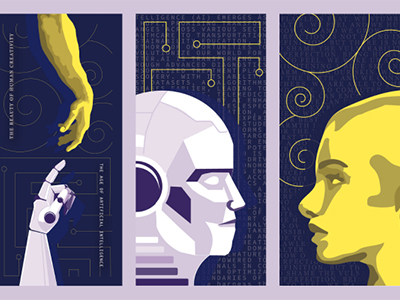WCU's college of Arts & humanities unveils new student-designed artwork on main hall
WCU’s College of Arts & Humanities (CAH) unveiled new artwork adorning Main Hall in the form of three large banners overlooking the Academic Quad. Rising Junior Art + Design student, Eleana Rudderow designed these banners based on a chosen theme by students in CAH’s 2023-2024 First Year Experience (FYE) program. The theme explored Human Creativity and the Age of Artificial Intelligence.
Dean of the College of Arts and Humanities Dr. Jen Bacon says, “Every year, we pick a theme for our College of Arts and Humanities Outdoor Gallery, and this year, we thought we’d let our First-Year Experience class participate in the process of choosing that theme.”
The FYE students had several great ideas, but the one that most intrigued them was a question of how artificial intelligence might shape their college experience.
 “Some were so excited about the potential, while others were very concerned that human
creativity would be diminished,” says Bacon. “That dramatic tension was what led to
the artistic brief, and to the selection of this wonderful work by Eleana, which captures
that moment of inspiration but leaves ambiguous which way the direction is flowing.”
“Some were so excited about the potential, while others were very concerned that human
creativity would be diminished,” says Bacon. “That dramatic tension was what led to
the artistic brief, and to the selection of this wonderful work by Eleana, which captures
that moment of inspiration but leaves ambiguous which way the direction is flowing.”
The concept of artificial intelligence is asking all disciplines and industries to evaluate its potential impact. Rudderow explains how she sees AI’s role in the artistic world and what influence it might have.
“Drawing on my knowledge of history and art, I see parallels between the impact of photography and the potential influence of AI. Just as photography transformed art by shifting focus to more expressive art forms, AI may similarly foster a deeper appreciation for human ingenuity in all things.”
Rudderow’s artwork aims to call attention to AI’s potential to strengthen appreciation for the humanities.
“While AI holds great power, when wielded responsibly, it can enhance society. I believe embracing AI offers a path toward a brighter future.”
Rudderow further explains her creative process for these banner pieces: “In contemplating the connection between humanity and AI, I recalled Michelangelo's Creation of Adam,” says Rudderow.
The largest of the three panels, which hangs over the door to Main Hall, directly references Michelangelo’s exquisite Sistine Chapel painting.
“In my rendition, I substituted the traditional depiction of God with a robotic figure, symbolizing the fusion of human and artificial elements.”
Rudderow’s work also utilizes color to further emphasize that fusion.
She says, “Through contrasting warm yellow hues with stark white, I accentuate the humanity within this union, showcasing its potential for greatness.”
In the two smaller panels, a human head is depicted facing toward a robotic head in an adjacent panel, embodying the figures whose hands are represented in the larger panel. This composition is meant to highlight the controversy that surrounds the theme. The adjacent panels each feature a paragraph of text as a background to the figureheads.
Rudderow explains, “On one side, an AI-generated passage extols the benefits of AI.”
While on the adjacent panel, “A heartfelt ‘Ode to Humanity’ celebrates human beauty.” The Ode was crafted by Cassidy McHugh, a rising Junior majoring in Philosophy.
Rudderow concludes, “My hope is that viewers will recognize the positive potential of AI to enrich education, communities, and the world; while honoring the essence of humanity.”
The banners will remain hanging on Main Hall for the entirety of the 2024-2025 Academic Year to inspire our campus community to contemplate this theme: Human Creativity and the Age of Artificial Intelligence.
